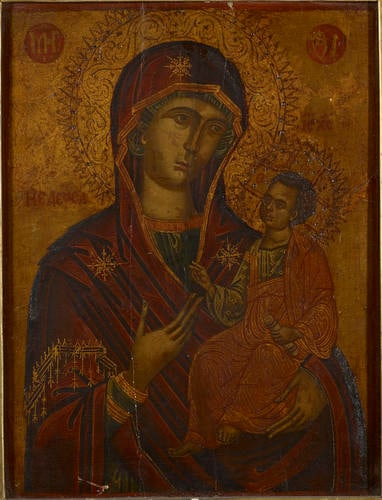-
1 of 253523 objects
The Virgin and Child ('Virgin Hodegetria') c.1400-1600
Panel | 29.6 x 22.7 cm (support, canvas/panel/stretcher external) | RCIN 403492

Byzantine School
The Virgin and Child ('Virgin Hodegetria') c.1400-1600
-
The term 'Byzantine' is used to refer to the art which emanated from the Eastern Christian Empire from the fourth century onwards, the capital of which was Byzantium or Constantinople, now Istanbul in Turkey. Although the term can often refer to a style, rather than a geographic place, Byzantine painting is recognisable by its formulaic appearance, highly-stylised figures and rich colours.
This painting is a devotional image known as an icon, a window through which the viewer can interact with the holy subjects within. The Virgin, draped in a maphorion (mantle) adorned with characteristic Greek crosses, acts as an intercessor here, mediating between the infant Christ and the viewer, to whom she presents her holy child as the way to Salvation. Jesus looks out and raises his hand in blessing. He is dressed in an undergarment known as a chiton along with the draped robe known as a himation, and holds a rotulus, a scroll of the written word rolled around a central rod. These are attributes of classical philosophers, adopted from ancient Greek art, and combine to present Christ as the embodiment of the Word (Logos) of God.
Like many others of its kind, both the format and spiritual power of this icon derive from a venerated Byzantine icon known as the Virgin Hodegetria, which translates as 'she who points the way'. The miraculous wooden panel became the subject of legend, and was much written about, re-produced and speculated upon from the eleventh century onwards. The icon came to be attributed to the hand of Saint Luke, and was housed in the Monastery of the Hodegon in Constantinople, made famous for its miraculous spring waters which cured blindness.
Icons depict a sacred and infinite presence, and so resist any reference to a set time or place. Here, the gold background removes the Virgin and Child from an everyday, earthly reality. Their haloes are decorated with swirling patterns and geometric shapes, along with holes punched directly into the gold ground.
Provenance
One of the group of Byzantine works from the 77 paintings belonging to Prince Ludwig von Oettingen-Wallerstein (1791-1870), which were first offered to Prince Albert in 1847 as security for a loan and came into his possession by default (no 5 in Waagen’s catalogue of 1854); 25 of them were accepted by the National Gallery in 1863.
-
Creator(s)
(artist) -
Medium and techniques
Panel
Measurements
29.6 x 22.7 cm (support, canvas/panel/stretcher external)
47.0 x 33.8 x 3.0 cm (frame, external)
Category
Object type(s)
Subject(s)
Alternative title(s)
The Virgin and Child